Greenback (1860s money)
This article needs additional citations for verification. (April 2021) |

Greenbacks were paper currency fiat money issued by the United States during the American Civil War that were printed in green on the back. They were in two forms: Demand Notes, issued in 1861–1862, and United States Notes, issued in 1862–1865. They were legal tender by law but were not backed by gold or silver, only the credibility of the U.S. government.[1]
History[]
Before Civil War[]
Before the Civil War, the only money issued by the United States was gold and silver coins and only such coins ("specie") were legal tender and so payment in that form had to be accepted.
Paper currency in the form of banknotes was issued by privately-owned banks, the notes being redeemable for species at the bank's office and not legal tender. Such notes had value only if the bank could be counted on to redeem them. If a bank failed, its notes became worthless.
National governments had issued paper money and made it legal tender, but that was usually with at least the pretense that the notes would be redeemable for species at some time. Continental dollars issued by the Continental Congress during the American Revolution had no such backing. They soon became almost worthless largely due to massive British counterfeiting of them as an act of war.[citation needed]
In the early 19th century, the U.S. issued interest-bearing Treasury Notes in various denominations. They were not legal tender but could be used to pay customs duties.[citation needed]
Civil War[]
When President Abraham Lincoln assumed office, he understood the importance of money for the war effort. With that in mind, Lincoln appointed Salmon P. Chase as Secretary of the Treasury. His position made authorized to act alone on all matters about the country's finances. Chase, like almost everyone at the time, underestimated the duration and the cost of the war.[2] Within a few months, the costs of the war would clearly run far beyond the government's limited income from tariffs and excises.
The Lincoln administration sought loans from major banks, mostly in New York City. The banks demanded very high-interest rates of 24 to 36 percent. Lincoln refused to borrow on such terms and called for other solutions.[citation needed]
Demand Notes[]



The first measure to finance the war occurred in July 1861, when Congress authorized $50,000,000 in Demand Notes. They bore no interest but could be redeemed for specie "on demand." They were not legal tender before March 1862 but, like Treasury Notes, could be used to pay customs duties.[citation needed] Unlike state and some private banknotes, Demand Notes were printed on both sides. The reverse side was printed in green ink and so the Demand Notes were dubbed "greenbacks." Initially, they were discounted relative to gold, but being fully redeemable in gold, they were soon at par. In December 1861, the government had to suspend redemption, and the Demand Notes declined. Chase authorized paying interest on Demand Notes, which sustained their value.[citation needed]
The later United States Notes could not be used to pay customs duties or interest on the public debt, which could be paid only by gold and Demand Notes. Importers, therefore, continued to use Demand Notes in place of gold. In March 1862, Demand Notes were made legal tender. As Demand Notes were used to pay duties, they were taken out of circulation. By mid-1863, about 95% of them had been gone.[citation needed]
United States Notes[]
The number of Demand Notes issued was far insufficient to meet the war expenses of the government but even so was not supportable.
The solution came from Colonel "Dick" Taylor, an Illinois businessman who was serving as a volunteer officer. Taylor met with Lincoln in January 1862 and suggested issuing unbacked paper money.[citation needed] Issuing unbacked paper money was not an idea that Lincoln really liked,[citation needed] but there was mounting pressure in Congress to do something. The government could either print its own money or go into deep perpetual debt to foreign creditors. That made President quickly endorse Taylor's proposal.[citation needed] On February 25, 1862, Congress passed the first Legal Tender Act, which authorized the issuance of $150 million in United States Notes.[3]
Since the reverse of the notes was printed with green ink, they were called "greenbacks" by the public and considered to be equivalent to the Demand Notes, which were already known as such. The United States Notes were issued by the United States to pay for labor and goods.[4]
Earlier, Secretary Chase had the slogan "In God We Trust" engraved on U.S. coins. During a cabinet meeting, there was some discussion of adding it to the U.S. Notes as well. Lincoln, however, humorously remarked, "If you are going to put a legend on the greenbacks, I would suggest that of Peter and Paul, 'Silver and gold I have none, but such as I have I give to thee.'"[nb 1][5]
California and Oregon defied the Legal Tender Act. Gold was more available on the West Coast, and merchants in those states did not want to accept U.S. Notes at face value. They blacklisted people who tried to use them at face value. California banks would not accept greenbacks for deposit, and the state would not accept them for payment of taxes. Both states ruled that greenbacks were a violation of their state constitutions.[5]
As the government issued hundreds of millions in greenbacks, their value against gold declined. The decline was substantial, but was nothing like the collapse of the continental dollar.
In 1862, the greenback declined against gold until by December, gold had become at a 29% premium. By spring of 1863, the greenback declined further, to 152 against 100 dollars in gold. However, after the Union victory at Gettysburg, the greenback recovered to 131 dollars to 100 in gold. In 1864, it declined again, as Grant was making little progress against Lee, who held strong in Richmond throughout most of the war. The greenback's low point came in July that year, with 258 greenbacks equal to 100 gold. When the war ended in April 1865 the greenback made another remarkable recovery to 150.[6] The recovery began when Congress limited the total issue of greenback dollars to $450 million. The greenbacks rose in value until December 1878, when they became on par with gold. Greenbacks then became freely convertible into gold.[citation needed]
Complete set of 1862–63 greenbacks[]
| Issue | Date[7] | Denominations |
|---|---|---|
| First | 10 March 1862 | $5, $10, $20 |
| Second | 1 August 1862 | $1 & $2 |
| Third | 10 March 1863 | $50 to $1,000 |
| Obligation | Obligation text[7] |
|---|---|
| First | This note is a legal tender for all debts, public and private, except duties on imports and interest on the public debt, and is exchangeable for the U.S. six percent twenty-year bonds, redeemable at the pleasure of the United States after five years. |
| Second | This note is a legal tender for all debts, public and private, except duties on imports and interest on the public debt, and is receivable in payment of all loans made to the United States. |
| Value | Year | Obligation | Fr. | Image | Portrait[nb 2] | Population[nb 3] |
|---|---|---|---|---|---|---|
| $1 | 1862 | Second[nb 4] | Fr.16c | 
|
Salmon P. Chase (Joseph P. Ourdan)[9] | 2,607 (194) |
| $2 | 1862 | Second | Fr.41 | 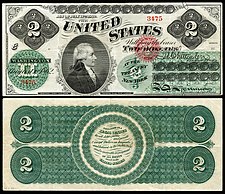
|
Alexander Hamilton | 1,212 (881) |
| $5 | 1862 | First | Fr.61a | 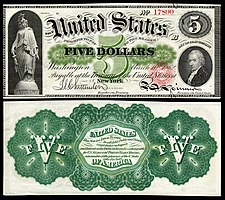
|
Freedom (Owen G. Hanks, eng; Thomas Crawford, art)[10] Alexander Hamilton | 1,591 (188) |
| $10 | 1863 | First | Fr.95b | 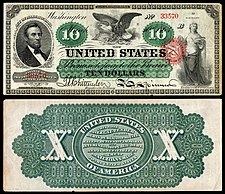
|
Abraham Lincoln (Frederick Girsch);[11] Eagle; Art | 375 (161) |
| $20 | 1863 | First | Fr.126b | 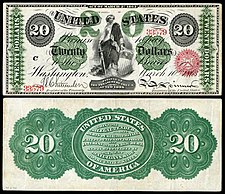
|
Liberty | 375 (161) |
| $50 | 1862 | Third | Fr.148a | 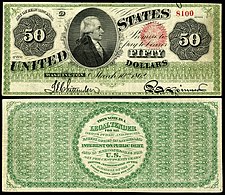
|
Alexander Hamilton (Joseph P. Ourdan)[12] | 45 (1) |
| $100 | 1863 | Third | Fr.167 | 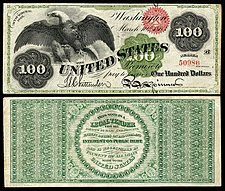
|
Vignette spread eagle (Joseph P. Ourdan)[13] | 51 (2) |
| $500 | 1862 | Third | Fr.183c | 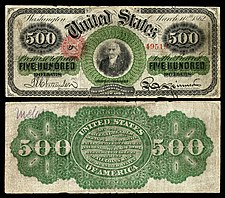
|
Albert Gallatin | 6 (4) |
| $1,000 | 1863 | Third | Fr.186e | 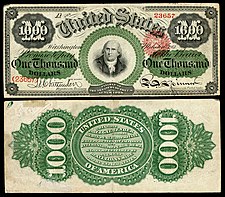
|
Robert Morris (Charles Schlecht) | 4 (1) |
See also[]
Notes[]
- ^ Acts 3:6
- ^ Names in parentheses are either the engravers or artists responsible for the concept and/or initial design.
- ^ The first number represents the total population[clarification needed] for the design type, the second number (in parentheses) is the total number of notes known for the variety illustrated in the table.
- ^ The $1 and $2 denominations were only issued with the Second obligation on the reverse. All other denominations were issued with both payment obligations.[8]
References[]
- ^ Brands 2011, p. 1.
- ^ Mitchell 1903, p. 3.
- ^ Brands 2011, p. 12.
- ^ O'Sullivan, Arthur; Sheffrin, Steven M. (2003). Economics: Principles in Action. Needham, MA: Pearson Prentice Hall. p. 552. ISBN 0-13-063085-3.
- ^ Jump up to: a b Leigh 2014, p. 50.
- ^ Brands 2011, p. 13.
- ^ Jump up to: a b Friedberg & Friedberg 2013, p. 37.
- ^ Friedberg & Friedberg 2013, pp. 37–56.
- ^ Hessler 2004, p. 24.
- ^ Hessler 2004, p. 20.
- ^ Hessler 2004, p. 22.
- ^ Hessler 2004, p. 27.
- ^ Hessler 2004, p. 28.
Sources[]
- Brands, H. W. (2011). Greenback Planet: How the Dollar Conquered the World and Threatened Civilization as We Know It. University of Texas Press. ISBN 9780292739338.
- Friedberg, Arthur L.; Friedberg, Ira S. (2013). Paper Money of the United States (20th ed.). Coin & Currency Institute. ISBN 978-0-87184-020-2. Retrieved 25 January 2020.
- Hessler, Gene (2004). U.S. Essay, Proof and Specimen Notes (2nd ed.). BNR Press. ISBN 0-931960-62-2.
- Mitchell, Wesley Clair (1903). A history of the greenbacks: with special reference to the economic consequences of their issue: 1862–65. University of Chicago Press.
- Oberholtzer, Ellis Paxson (1904). Abraham Lincoln. Philadelphia: George W. Jacobs. Vol.I Vol.II
- Oberholtzer, Ellis Paxson (1907). Jay Cooke: Financier of the Civil War. Philadelphia: George W. Jacobs. Vol.I Vol.II
Further reading[]
- Bye, John O. (1963). Lincoln's greenback currency. University of Michigan.
- Noll, Franklin (March 2012). "The United States Monopolization of Bank Note Production: Politics, Government, and the Greenback, 1862–1878". American Nineteenth Century History. 13 (13): 15–43. doi:10.1080/14664658.2012.681942. S2CID 144566502.
- 1861 establishments in the United States
- 1865 disestablishments in the United States
- Currencies introduced in 1861
- Historical currencies of the United States
- Economic history of the American Civil War
- Paper money of the United States
- Banknotes of the United States
- Green